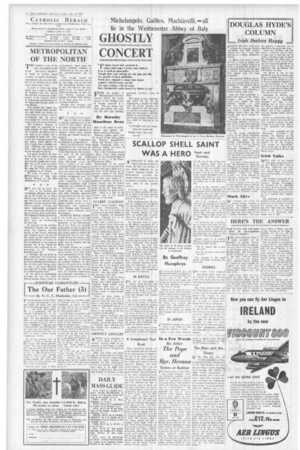Page 4, 19th July 1957
Page 4

Report an error
Noticed an error on this page?If you've noticed an error in this article please click here to report it.
Tags
Share
Related articles
Proust Dips His Cake
Spain Rededicated To Patron Saint
The Conversion Of The Pagan Gods
Abstinence
Kalendar Of The Week
SCALLOP SHELL SAINT WAS A HERO Feast
By Geoffrey Humphrys
LTHOUCiH St. James the Great is the patron saint of Spain, his feast day of July 25 was widely celebrated by our Catholic ancestors before the Reformation. Customs connected with the day were in fact continued in London up to the
early part of the present century.
According to the legendary story. St. James preached the Gospel jn Spain, afterwards returning to Palestine to be made the first Bishop of Jerusalem. While preaching from the summit of a temple. he was thrown over the battlements and killed by the Jews. Some Spanish converts who had followed him to Jerusalem. however, rescued his holy relics and carried them to Spain, where they were miraculously discovered in the 8th century. The Spaniards hold St. James in the highest veneration, for at the Battle of Clavijo fought in the year 841 against the Moors, he is said to have appeared on the field
VI
when the day as going hard for the Christians, Armed with a sword of dazzling splendour and mounted on a white horse emblazoned with heraldic scallop shells, the saint slew sufficient of the infidels to bring victory to Spain and Christianity. The great Spanish order of knighthood, Santiago de Espada — St. James of the Sword, was founded in commemoration of this miraculous event. Thus the apostle James, peaceful fisherman of the Lake of Gennesaret, was transformed by the Spaniards into a valorous knight who championed their cause of Christianity.
IN BATTLE
THE city of Compostella in Galicia, where the holy relics were found, became the chief seat of the Order of St. James. The badge of the Order is a bloodstained sword in the form of a cross and charged with heraldic scallop shells. The banner of the Order, preserved in the armory at Madrid, is said to have been the standard used by Ferdinand and Isabella at the conquest of Grenada. It depicts St. James as he appeared at the Battle of Clavijo, but according to Spanish history this was not his only appearance in battle, and because of this St. James's Day has always been considered auspicious for Spanish armies.
The shrine of St. James at Cornpostella was a great resort of pilgrims from all parts of Christen dom during the Middle Ages. "1 he distinguished badge of pilgrims to the shrine was a scallop shell worn on the cloak or hat. This is accounted for by the legend concerning the journey of St. James's relics from Jerusalem to Spain in a ship built of marble. Alarmed at the sight of such a vessel, the horse of a Portuguese knight is said to have plunged into the sea with its rider. The knight was duly rescued and taken aboard the ship, when it was found that his clothes were covered with scallop shells. The knight's deliverance being attributed to the influence of St. James, the scallop shell became. the symbol of his favour.
IN JAPAN
CURIOUSLY enough, the scallop shell is still borne by some present day pilgrims in Japan.
There is little doubt, however,
that the use of the scallop shell as a pilgrim's badge, both in Europe and the East. was also connected with its primitive use as a cup, dish or spoon. The heraldic cleat of an old English family named Dishington bears a scallop shell. This is a case of a punning allusion to the name and the ancient use of the shell as a dish.
Proof of the universal popularity of Christian pilgrimages to Compostella exists in the fact that 17 English peers and eight baronets still have scallop shells incorporated in their heraldic arms.
aue to the popularity of the sang and the association of shells with his name, it was once customary in London for the oyster eating season .to start on St. James's Day. This gave rise to the saying, " Whoever cats oysters on St. James's Day, will never want money." • The reason for this is probably that as oysters were dearer on this day than later in the season only the richer people could afford them. It also served as lighthearted encouragement for others to indulge in a little extravagance.
Further proof of St. James's influence in England appears in the old Herefordshire saying: " Till St. James's Day is past and gone, There on,, renmaeybe hops or there may he This referred to the noted annual uncertainty concerning the local crop.
PENNIES
THE custom which continued until almost recent years was the practice of children collecting oyster shells during the few days following the opening of the oyster season.
They hung around, taverns and fish shops gathering as many shells as they could. By the time old St. James's Day (August 5) came round, they had sufficient to make piles of them in various ornamental forms on the pavements. At night, a candle was placed on the top of these often ingenious little creations and passers-by were invited to " Mind the Grotto" or give "A penny for the Grotto." The claim for the pennies was ostensibly to keep the candle burning, but the efforts of some of the more enterprising children were rewarded to a much greater measure.
blog comments powered by Disqus









